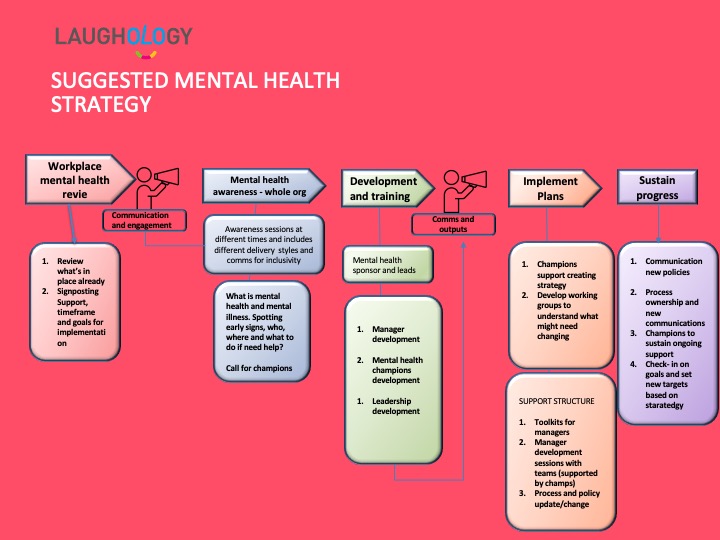.
How to create a mental health strategy for your workplace
Creating a mental health strategy for your workplace and looking after people, is an important step towards a supportive workplace culture, where people feel comfortable talking about their mental health and wellbeing. It also helps you feel confident to support them. Stephanie Davies has some tips to help you put your mental health strategy together.
Everyone is different
Everyone is different, with contrasting needs, values and levels of resilience. As a result, monitoring mental health and wellbeing within the workplace is a skill. Managers and leaders must be aware of the different personalities within their teams. One size does not fit all.
Over the years, Laughology has been a pioneering advocate of creating workplace cultures where people matter. Back in 2006 when we were just starting out, wellbeing and happiness were seen as ‘fluffy’ concepts. Many organisations placed profit and productivity above happiness and wellbeing at all costs.
I once had a conversation with an exec at a well-known bank. He told me he knew how his team were feeling by monitoring his numbers dashboard. In contrast, I was a wet-behind-the-ears new business owner who passionately believed that everyone was an individual. Addressing the individual and their needs was the starting point from which to create better workplaces.
I asked the naive question,
“But how do you know how people are feeling by looking at the numbers?”
He replied,
“Because I know if they’re hitting their targets.”
Bemused by this, I pointed out that just because someone meets a target doesn’t mean they’re happy or enjoying their work. If they’re not happy or engaged, what happens then?
“Don’t you need to understand how they’re feeling?” I asked.
He scoffed. In those days if you used the word ‘feeling’ in certain business conversations, people assumed you were some kind of New Age hippy.
Needless to say, that was the end of the conversation.
Looking after people is the most important part of any business
Thankfully, we’ve evolved a long way since then. A financial crash, a steady increase in workplace mental health issues and a growing productivity gap in UK business has shown execs like the one I spoke to all those years ago that people aren’t just machines you can programme to reach targets. Since Laughology started over 15 years ago, organisations – led by HR and L&D functions - have realised that looking after their people is the most important part of any business.
Workplaces need long-term mental health strategies
The pandemic brought this to the surface even more. However, we need to go further. And whilst mental health workshops and wellbeing programmes are helpful, workplaces need strategies and long-term behaviour change.
Supporting managers to create a culture of psychological safety is an important part of this. They require the skills to spot early signs and to conduct sensitive and supportive conversations. And it can’t just stop there.
Once managers are trained, regular interventions are needed. These can be by mental health champions who regularly meet with managers and teams to identify and raise any issues. Managers and leaders need to have regular check-ins too, and policies need to be changed where necessary.
These measures take time and effort. The rewards for organisations and their people, however, are too significant to ignore.
Below is a simple diagram to help get you started.

How leaders and managers can make a difference
Here are some ways leaders and managers at all levels can start to make a difference. Please note that this is practical guidance, not legal advice.
- Discuss mistakes you make and talk about your personal journey. This helps normalise mistakes and challenges and even mental illness episodes.
- Put in time for wellbeing. This can be going for a walk or having lunch away from your desk. It’s important to put this in diaries across your organisation.
- Talk about psychological safety. What are the things that help or hinder? Be open to change. Ask for honest feedback from your team and continually check in on this.
- Have no meeting days. Put at least one day in the diary where no meetings happen. Lead from the top and have a whole organisation approach to this.
- Encourage phone calls over video calls, which have become ubiquitous and are frequently unnecessary. Often a five-minute chat will suffice.
- Talk about mental health. Encourage your team to look out for each other by sharing information on signs to look out for.
- Listen and check in regularly. Make time for chats about stuff other than work.
- Be consciously inclusive. Modify policies and practices so everyone is heard and included.
If you’d like further support and ideas for creating a mental health strategy for your workplace, why not join us for Our Big Chat about thinking outside the tick box. We’ll be discussing the mental health emergency with guest speakers including Professor Sir Cary Cooper.
Tags - mental health and wellbeing
























